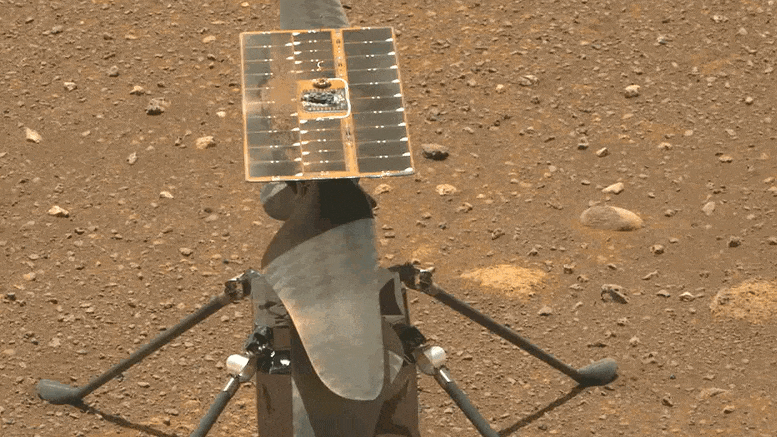
The Ingenuity Mars Helicopter’s carbon fiber blades can be seen in this video taken by the Mastcam-Z instrument aboard NASA’s Perseverance Mars rover on April 8, 2021, the 48th Martian day, or sol, of the mission. They are performing a wiggle test before the actual spin-up to ensure they were working properly. Credit: NASA/JPL-Caltech/ASU
With its recent 21st flight complete, the Red Planet rotorcraft is on its way to setting more records during its second year of operations.
NASA has extended flight operations of the Ingenuity Mars Helicopter through September. In the months ahead, history’s first aircraft to operate from the surface of another world will support the Perseverance rover’s upcoming science campaign exploring the ancient river delta of Jezero Crater. Along the way, it will continue testing its own capabilities to support the design of future Mars air vehicles.
The announcement comes on the heels of the rotorcraft’s 21st successful flight, the first of at least three needed for the helicopter to cross the northwest portion of a region known as “Séítah” and reach its next staging area.
“Less than a year ago we didn’t even know if powered, controlled flight of an aircraft at Mars was possible,” said Thomas Zurbuchen, the associate administrator of NASA’s Science Mission Directorate. “Now, we are looking forward to Ingenuity’s involvement in Perseverance’s second science campaign. Such a transformation of mindset in such a short period is simply amazing, and one of the most historic in the annals of air and space exploration.
NASA’s hard at work on the Red Planet. Watch the latest Mars Report for more on Ingenuity, along with the agency’s Perseverance and Curiosity rovers. Credit: NASA/JPL-Caltech
Ingenuity’s new area of operations is entirely different from the modest, relatively flat terrain it has been flying over since its first flight last April. Several miles wide and formed by an ancient river, the fan-shaped delta rises more than 130 feet (40 meters) above the crater floor. Filled with jagged cliffs, angled surfaces, projecting boulders, and sand-filled pockets that could stop a rover in its tracks (or upend a helicopter upon landing), the delta promises to hold numerous geologic revelations – perhaps even the proof necessary to determine that microscopic life once existed on Mars billions of years ago.
Upon reaching the delta, Ingenuity’s first orders will be to help determine which of two dry river channels Perseverance should take when it’s time to climb to the top of the delta. Along with routing assistance, data provided by the helicopter will help the Perseverance team assess potential science targets. Ingenuity may even be called upon to image geologic features too far afield (or outside of the rover’s traversable zone), or perhaps scout landing zones and caching sites for the Mars Sample Return program.
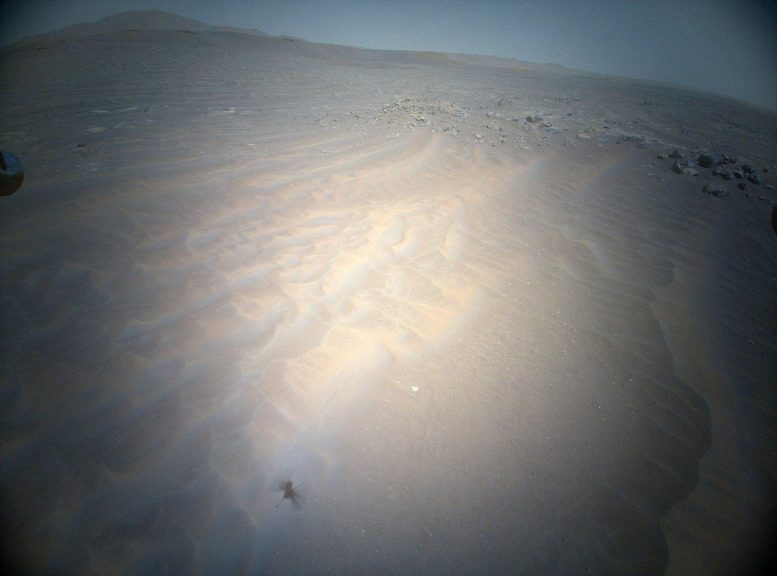
NASA’s Ingenuity Mars Helicopter acquired this image in the northwest portion of a region known as “Séítah” using its high-resolution color camera during its 20th flight on February 25, 2022. Credit: NASA/JPL-Caltech
“The Jezero river delta campaign will be the biggest challenge the Ingenuity team faces since first flight at Mars,” said Teddy Tzanetos, Ingenuity team lead at NASA’s Jet Propulsion Laboratory in Southern California. “To enhance our chances of success, we have increased the size of our team and are making upgrades to our flight software geared toward improving operational flexibility and flight safety.”
Higher Flights
Several of these upgrades have led to reduced navigation errors during flight, which increases both flight and landing safety. A recent software change already on the rotorcraft frees Ingenuity from its previously programmed maximum altitude of 50 feet (15 meters). The altitude gains could result in incremental increases in both air speed and range. A second upgrade allows Ingenuity to change airspeed as it flies. Another enables it to better understand and adjust to changes in terrain texture during flight. Future software upgrades may include adding terrain elevation maps into the navigation filter and a landing-hazard-avoidance capability.
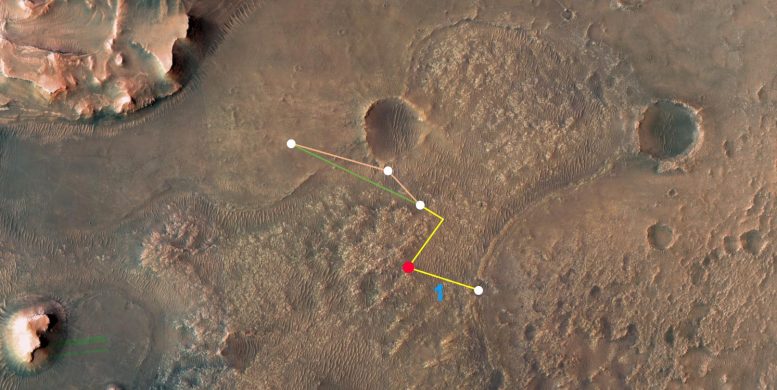
This annotated image depicts the multiple flights – and two different routes – NASA’s Ingenuity Mars Helicopter could take on its trip to Jezero Crater’s delta. Credit: NASA/JPL-Caltech/University of Arizona/USGS
Before aerial reconnaissance of the delta can begin, Ingenuity has to complete its journey to the area. Scheduled for no earlier than March 19, Ingenuity’s next flight will be a complex journey, about 1,150 feet (350 meters) in length, that includes a sharp bend in its course to avoid a large hill. After that, the team will determine whether two or three more flights will be required to complete the crossing of northwest Séítah.
The first experimental flight on another world took place on April 19, 2021, and lasted 39.1 seconds. After another four flights, six more minutes in the air, and traveling a total distance of 1,637 feet (499 meters), NASA transitioned Ingenuity into an operations demonstration phase, testing its ability to provide an aerial dimension to the Perseverance mission. With the completion of Flight 21, the rotorcraft has logged over 38 minutes aloft and traveled 2.9 miles (4.64 kilometers). As Ingenuity pushes farther into uncharted territory, these numbers will inevitably go up, and previous flight records will more than likely fall.
“This upcoming flight will be my 22nd entry in our logbook,” said Ingenuity chief pilot Håvard Grip of JPL. “I remember thinking when this all started, we’d be lucky to have three entries and immensely fortunate to get five. Now, at the rate we’re going, I’m going to need a second book.”
More About Ingenuity
The Ingenuity Mars Helicopter was built by JPL, which also manages this technology demonstration project for NASA Headquarters. It is supported by NASA’s Science Mission Directorate. NASA’s Ames Research Center in California’s Silicon Valley and NASA’s Langley Research Center in Hampton, Virginia, provided significant flight performance analysis and technical assistance during Ingenuity’s development. AeroVironment Inc., Qualcomm, and SolAero also provided design assistance and major vehicle components. Lockheed Space designed and manufactured the Mars Helicopter Delivery System.
At NASA Headquarters, Dave Lavery is the program executive for the Ingenuity Mars Helicopter.
More About Perseverance
A key objective for Perseverance’s mission on Mars is astrobiology, including the search for signs of ancient microbial life. The rover will characterize the planet’s geology and past climate, pave the way for human exploration of the Red Planet, and be the first mission to collect and cache Martian rock and regolith (broken rock and dust).
Subsequent NASA missions, in cooperation with ESA (European Space Agency), would send spacecraft to Mars to collect these sealed samples from the surface and return them to Earth for in-depth analysis.
The Mars 2020 Perseverance mission is part of NASA’s Moon to Mars exploration approach, which includes Artemis missions to the Moon that will help prepare for human exploration of the Red Planet.
JPL, which is managed for NASA by Caltech in Pasadena, California, built and manages operations of the Perseverance rover.

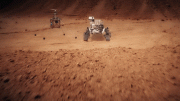
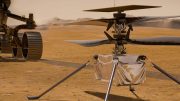

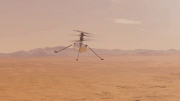
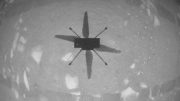
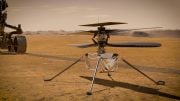
Very Interesting. Some initial Thoughts.
1. Mars Ingenuity helicopter is quite Ingenious.
2. Helicopter Flights is achieved rotating Helicopter Blades, to produce Lift in the atmosphere to enable the machine to lift off the ground and then move forward.
3. Let us look at Earth Versus Mars Helicopter Flights by comparing the critical elements to be overcome to achieving such flight o the Planet Mars: LOOK at Comparative Data shown below:
EARTH MARS
Average Distance from Sun 93 million miles 142 million miles
Average Speed in Orbiting Sun 18.5 miles per second 14.5 miles per second
Diameter 7,926 miles 4,220 miles
Tilt of Axis 23.5 degrees 25 degrees
Length of Year 365.25 Days 687 Earth Days
Length of Day 23 hours 56 minutes 24 hours 37 minutes
Gravity 2.66 times that of Mars 0.375 that of Earth
Temperature Average 57 degrees F Average -81 degrees F
Atmosphere nitrogen, oxygen, argon, others mostly carbon dioxide, bit water vapor
Number of Moons 1 2
The Key Parameters to be noted for Helicopter Flight are
(1) Gravity to be overcome by the Helicopter Blades to get lift off. This includes the following:
a. Suns Gravitational impact on the planet Mars.
b. Two Moons of Mars Graitational Impact on Planet Mars.
c. Earths Gravitational IMpact on Planet Mars.
d. Gravitationa Impact of other Solar System Planets and their Moons on the Planet Mars.
(2) The atmosphere existng for low height flying operations in the atmosphere of Mars.Also for greater altitude operations.
(3) The Temperature on the surface of the planet and variation of the temperature as the helicopter gains height. Dry Ice (Solid Carbon Di Oxide) freezes at minus 109 degrees, so it should not be a problem.
a. Dry Ice also sublimates. Goes Directly from Solid to Gas , without a liquid phase.
b. Dont know about Air Pockets and the thickness of the carbon-di-oxide on the Plnet Mars and how much traction the Flying Martian Helicopter Can gain, to gain Height and also achieve Forward flying distnce.
(4) Will need a collission avoidance system in-built into these future helicopters. Dont know if software code can be modifed to include such a feature in the current ingenuity helicopter.
Views expressed are personal and not binding on anyone.